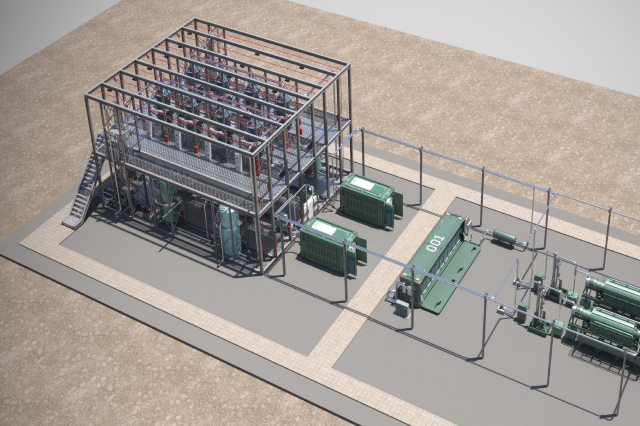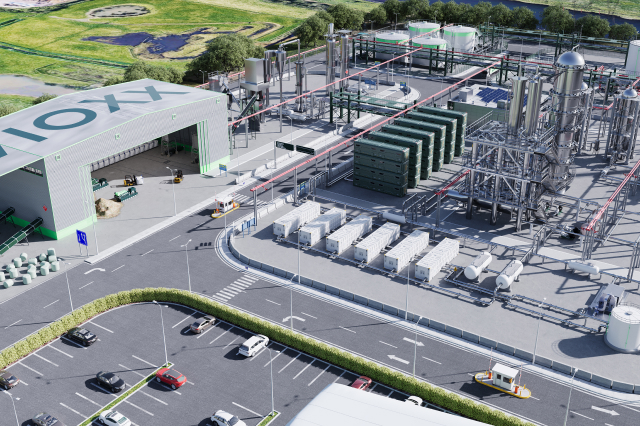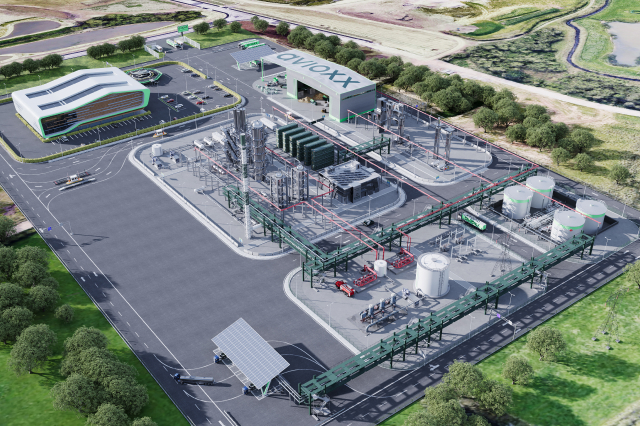How Solid Oxide Fuel Cells Will Change the Future of Flying
By Myfanwy Fleming-Jones

There are many different types of fuel cells, all of which harness the power of electrochemistry. These fuel cells are generators that leverage electrochemistry to make power from waste without combustion.
With Avioxx, when making sustainable aviation fuel (SAF) we integrate these fuel cells into the production process to increase manufacturing efficiency and reduce production costs.
The design of these fuel cells includes a negative electrode (an anode) and a positive electrode (a cathode) sandwiched around an electrolyte. These components undergo an electrochemical reaction to produce an electric current. The electrolyte is an ion conductor that moves ions from the fuel to the air or from the air to the fuel to create electron flow. Electrolytes vary among fuel cell types, and depending on the electrolyte used, fuel cells undergo slightly different electrochemical reactions, use different catalysts, run on different fuels, and achieve varying efficiencies.
For decades, experts have considered Solid Oxide Fuel Cells (SOFCs) to hold the greatest potential of any fuel cell technology due to their extremely high electrical efficiencies and low operating costs. SOFCs will likely emerge as the fastest-growing fuel cell segment over the next six years.1
Types of Fuel Cells
In addition to SOFCs, which is our main focus at Avioxx due to their high efficiency, fuel flexibility, and ability to utilise waste heat for additional energy, there are Proton Exchange Membrane Fuel Cells (PEMFC), Molten Carbonate Fuel Cells (MCFC), Phosphoric Acid Fuel Cells (PAFC), Alkaline Fuel Cells (AFC), and Direct Methanol Fuel Cells (DMFC). Each of these fuel cells has its own benefits: the PEMFC is used in vehicles and portable power systems, MCFC can use external CO2 in the reaction, and DMFCs offers an easy design with simple storage benefits.
Each type of fuel cell has specific application areas based on unique characteristics, such as operating temperature, fuel flexibility, and efficiency. This efficiency is due to there being no moving parts within the chemical process such as an electricity generator. The choice of fuel cell type depends on the intended application, cost considerations, and the availability of fuel.
The Solid Oxide Fuel Cell
Avioxx has chosen to focus on SOFCs because they can help reduce the cost of jet fuel production in several ways, primarily due to their potential for integration with existing infrastructure. One key reason is their high efficiency, which means less fuel is required to produce the same amount of electricity compared to competing technologies. This leads to reduced fuel consumption and lowers the cost of SAF over time.
Additionally, SOFCs can utilise a wide range of fuel sources and as a result, they play a significant role in reducing energy costs. Their ability to co-generate heat and power, and potentially produce other valuable by-products, adds further economic benefits, making them an attractive option for current and future energy systems.
Another important factor is the fuel flexibility of SOFCs. These cells can operate on various fuels, including natural gas, biogas, hydrogen, and synthetic fuels. This flexibility allows for the use of locally available and potentially cheaper fuels, including renewable and waste-derived fuels.
Introducing The Avioxx Process
The Avioxx process is a modification of an established pathway for making sustainable aviation fuel (SAF) using the Fischer-Tropsch process and harnessing the energy within municipal waste. Typical power-to-liquid processes convert captured CO2 to syngas, which requires significant external electricity for carbon capture. Further, additional electricity is needed to generate hydrogen from the electrolysis of water. However, the Avioxx process utilises energy from waste to generate electricity using SOFCs, eliminating the need to purchase large amounts of external electricity.
Avioxx chose SOFCs because they produce low levels of pollutants, such as NOx or SOx, and when running on hydrogen or biogas, they can achieve near-zero carbon emissions. The turn of the century has also marked a renewed focus on SOFC development due to the growing demand for clean energy solutions, only recently making advances in cost-effectiveness, scalability, and long-term durability. Two reactors are used in the process, with SOFCs being one of them. Additionally, oxygen is used for gasification, which is more efficient than using air for this process.
Avioxx also has a pending patent related to electricity generation using SOFCs for sustainable fuel production, and there are plans to further research the use of syngas with SOFCs to ensure compatibility and effective carbon monoxide to hydrogen ratios moving forward.
Further details about the Avioxx process can be found in this article.

The production and use of sustainable aviation fuel (SAF) offer several economic benefits for the aviation industry, fuel production sectors, and broader economies. The growth of the SAF market could lead to the development of new industries and supply chains, creating new business opportunities and stimulating economic activity. This could be particularly beneficial in rural or economically disadvantaged areas where feedstocks are grown or waste is collected.
Although initial SAF production costs may be higher than those of conventional jet fuel, advancements in technology such as Avioxx’s use of SOFCs for fuel production and economies of scale may reduce costs over time. As the industry matures, SAF prices could become more competitive with fossil-based jet fuels, particularly as carbon pricing and regulatory pressures on fossil fuels increase.
SAF has a lower carbon intensity compared to conventional jet fuel, which could result in lower carbon offset costs for airlines. As the aviation industry faces increasing pressure to reduce its carbon footprint, the economic advantage of using SAF will likely become more pronounced.2 The UK Government has also acknowledged the importance of this transition away from fossil fuels by mandating the use of SAF in the UK. SAF is also compatible with existing aircraft engines and fueling systems, meaning it can be integrated into current aviation infrastructure without costly modifications, furthering the importance and easy incorporation of SAF into general consumption.
SAF represents a sustainable, long-term solution for meeting the aviation sector's energy needs as the world transitions away from fossil fuels. This sustainable way forward that Avioxx is creating is the future of the flying industry.
For more information about Avioxx and our SAF development programme, please get in touch at info@avioxx.com.
1 Singh, M., Zappa, D., & Comini, E. (2021). Solid oxide fuel cell: Decade of progress, future perspectives and challenges. International Journal of Hydrogen Energy, 46(54), 27643-27674. https://doi.org/10.1016/j.ijhydene.2021.06.020
2 https://www.gov.uk/government/consultations/mandating-the-use-of-sustainable-aviation-fuels-in-the-uk



